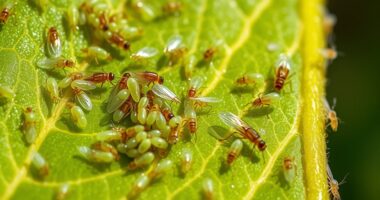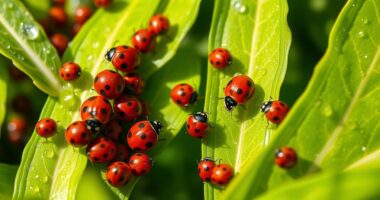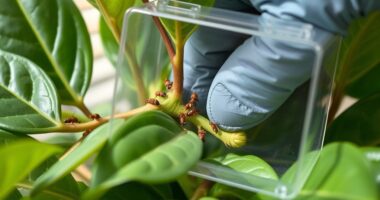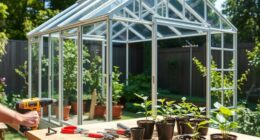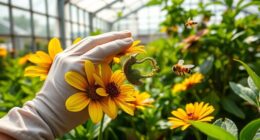To spot plant diseases early in your greenhouse, look for subtle signs like discolored spots, fuzzy mold, or wilting leaves that appear before major symptoms emerge. Conduct daily inspections using a magnifying glass or digital tools to catch stress signals and monitor environmental conditions like humidity and airflow. Regular sanitation and pest control also help prevent disease spread. Keep an eye on these indicators and techniques to catch problems early and protect your crops effectively.
Key Takeaways
- Conduct daily visual inspections for early signs like discolored spots, mold, or wilting leaves.
- Use magnifying tools and high-resolution cameras to detect subtle disease symptoms promptly.
- Monitor environmental conditions such as humidity and airflow that influence fungal development.
- Recognize early stress signals that may indicate underlying disease before visible symptoms appear.
- Isolate and treat affected plants immediately to prevent disease spread within the greenhouse.

How can farmers identify plant diseases before they spread uncontrollably? The key lies in early detection, which allows you to take swift action to prevent devastating losses. In a greenhouse setting, fungal outbreaks are a common threat that can quickly escalate if not caught early. Recognizing the signs of fungal infections—such as discolored spots, fuzzy mold, or wilting leaves—helps you intervene before the disease takes hold. Regular monitoring is essential; walk through your greenhouse daily and pay close attention to the health of your plants. Use a combination of visual inspections and, when possible, even handheld tools like magnifying glasses to spot subtle changes that might indicate the beginning of a fungal outbreak. Incorporating hydration strategies can also support plant resilience and help detect early stress signals that precede visible disease symptoms.
Early detection through daily inspection helps prevent the spread of plant diseases in greenhouses.
In addition to fungal threats, pests often carry diseases or cause physical damage that can serve as entry points for pathogens. Effective pest management plays a critical role in disease prevention. Keeping pests under control minimizes the risk of fungi and bacteria infiltrating plant tissues. You should establish a thorough pest management plan that includes regular scouting, the use of beneficial insects, and appropriate chemical treatments if necessary. Maintaining proper sanitation—removing fallen leaves, trimming infected branches, and disinfecting tools—also reduces the likelihood of disease spread. When pests are managed proactively, you create a less hospitable environment for fungi and other pathogens to take hold. Regular training of staff on pest and disease identification enhances early detection efforts and ensures swift response actions. Additionally, considering appliance testing methods can help ensure any equipment used does not inadvertently introduce contaminants or compromise humidity and airflow conditions that influence fungal development. Implementing digital monitoring tools can further aid in early identification by providing real-time data on environmental conditions conducive to fungal growth. Staying updated on disease-resistant plant varieties can also significantly lower the risk of outbreaks and facilitate easier management.
Another essential step is understanding the specific disease symptoms common to your crops. Different fungal outbreaks exhibit particular signs, such as powdery mildew, downy mildew, or root rot, each requiring tailored responses. Educate yourself about these indicators so you can differentiate between healthy and compromised plants quickly. Utilizing technology can further enhance early detection; digital tools like high-resolution cameras or sensor systems can alert you to stress signs invisible to the naked eye. Early diagnosis enables you to isolate affected plants immediately, preventing the disease from spreading to healthy specimens.
Furthermore, implementing preventative measures, such as improving airflow and reducing humidity, creates an environment less conducive to fungal growth. Proper watering practices—avoiding overhead irrigation and ensuring proper drainage—also help keep fungal outbreaks at bay. Remember, the sooner you recognize the initial symptoms, the easier it is to contain and eliminate the problem. By staying vigilant and combining good pest management practices with keen observation, you gain control over plant health and safeguard your greenhouse crop yields.
Frequently Asked Questions
What Are the Common Signs of Plant Disease in Different Greenhouse Crops?
You should look for common signs of plant disease in your greenhouse crops, like disease symptoms such as leaf spots, wilting, or mold. Plant discoloration is also a key indicator, often showing yellowing, browning, or bleaching. These symptoms can vary across different crops but noticing them early helps you take action. Regular inspections and understanding specific disease symptoms for each plant type will help keep your greenhouse healthy.
How Can Environmental Factors Influence Disease Development in Greenhouses?
Environmental factors play a vital role in disease development in your greenhouse. Poor pest management can lead to increased pest populations, spreading diseases quickly. Additionally, nutrient deficiencies weaken plant defenses, making them more susceptible. Temperature, humidity, and airflow also influence pathogen growth. By maintaining ideal conditions, managing pests effectively, and ensuring proper nutrition, you can considerably reduce disease risks and promote healthy plant growth.
Are There Specific Tools or Technology Recommended for Early Detection?
You should consider using sensor technology and imaging techniques for early detection. Sensors can monitor environmental conditions like humidity, temperature, and soil moisture, alerting you to potential issues. Imaging techniques, such as multispectral or hyperspectral imaging, help identify early signs of disease before visible symptoms appear. Combining these tools allows you to catch problems early, reducing crop loss and maintaining healthy plants in your greenhouse.
How Often Should Greenhouse Plants Be Inspected for Diseases?
Think of your greenhouse as a vigilant guardian, constantly watching over its precious plants. You should establish a regular monitoring frequency, inspecting your plants at least twice a week. An effective inspection schedule helps catch early signs of disease before they spread. This routine keeps your green sanctuary healthy and thriving, ensuring you act swiftly when issues arise. Consistency is your best tool in maintaining disease-free, vibrant plants.
What Are the Best Practices for Preventing Disease Spread Once Detected?
You should implement strict sanitation protocols and quarantine procedures to prevent disease spread once detected. Regularly disinfect tools, containers, and surfaces to eliminate pathogens. Isolate infected plants immediately and keep them separate from healthy ones. Monitor quarantine areas closely, and only reintroduce plants after confirming they’re disease-free. By maintaining these practices, you reduce the risk of contamination and protect your entire greenhouse from widespread infections.
Conclusion
By staying vigilant and catching plant diseases early, you can prevent small problems from snowballing into big disasters. Regular inspections and quick action are your best tools to nip issues in the bud. Remember, a stitch in time saves nine—addressing trouble early keeps your greenhouse thriving. Don’t wait until it’s too late; being proactive now guarantees healthy plants and a bountiful harvest in the long run.


